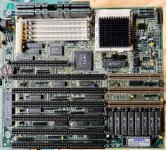Paul-VT
Member
I'm working on a QDI V4P895P3/SMTP3 V4.0 486 motherboard. At POST, there is a message that says "CACHE MEMORY BAD, DO NOT ENABLE CACHE!". This message only appears if external cache is enabled in the BIOS. If L2 is disabled, the board boots fine and is stable. If L2 is enabled, the board works but is sometimes unstable but no L2 cache is detected by common cache diagnostic programs. The jumpers and chips shown in the photo may not be correct as I was a'mid-test.
I have tried:
1. Check and recheck all jumpers
2. Check voltages on board and on cache chips
3. Check clock signal and waveform
4. Swapped in known good cache chips
5. Tried different amounts of cache
6. Tried different CPUs with speeds of 66 and 100MHz
7. Tried different RAM.
8. Dumped the BIOS and checked it against one that I found on TheRetroWeb
9. Looked for damaged traces and solder joints on board
Questions:
1. Could this be one of those "fake cache" boards? Seems unlikely as the cache is socketed.
2. Can anyone suggest which ICs or other discrete components may be the culprit?
Thanks
-Paul in Vermont
I have tried:
1. Check and recheck all jumpers
2. Check voltages on board and on cache chips
3. Check clock signal and waveform
4. Swapped in known good cache chips
5. Tried different amounts of cache
6. Tried different CPUs with speeds of 66 and 100MHz
7. Tried different RAM.
8. Dumped the BIOS and checked it against one that I found on TheRetroWeb
9. Looked for damaged traces and solder joints on board
Questions:
1. Could this be one of those "fake cache" boards? Seems unlikely as the cache is socketed.
2. Can anyone suggest which ICs or other discrete components may be the culprit?
Thanks
-Paul in Vermont

